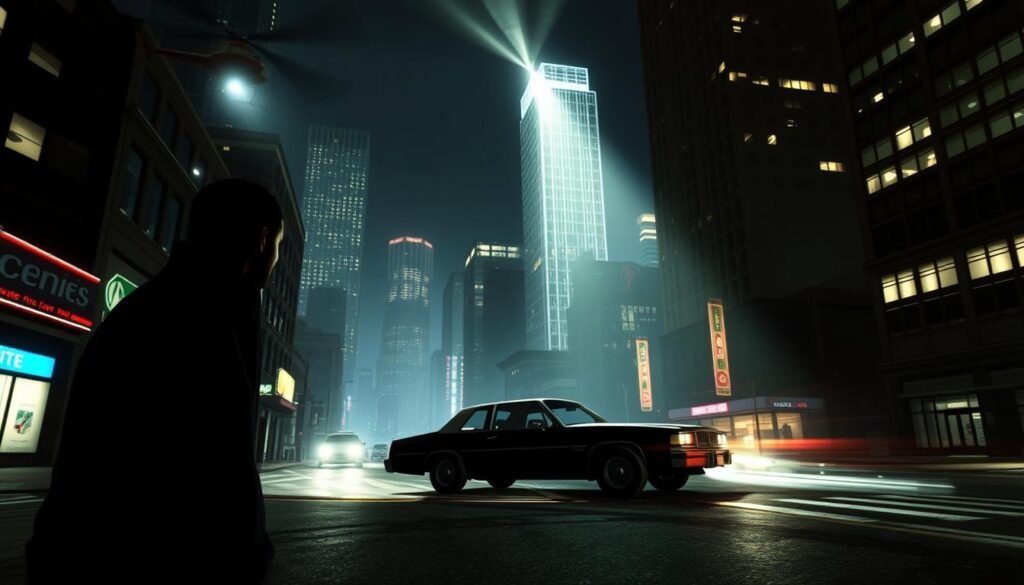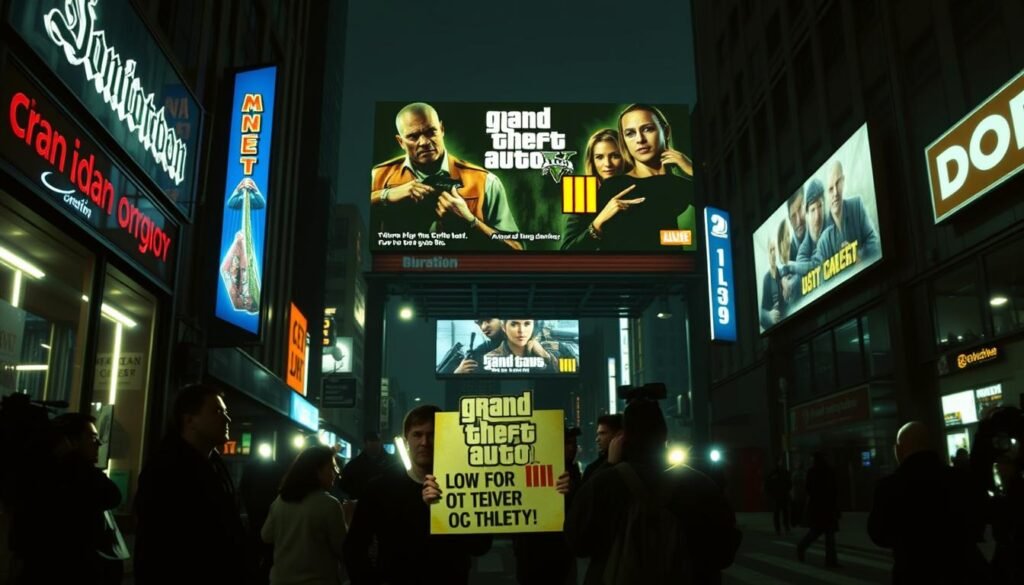GTA III: The Game That Changed Open-World Forever
The release of Grand Theft Auto, GTA III marked a significant turning point in the gaming industry, revolutionizing the concept of open-world gaming. This groundbreaking game introduced a new level of freedom and immersion, allowing players to explore a vast, interactive environment.

GTA III
The impact of GTA III was immense, influencing a generation of gamers and game developers alike. Its innovative gameplay mechanics and engaging storyline set a new standard for the industry, paving the way for future open-world games.
The Pre-GTA III Gaming Landscape
The gaming industry was about to undergo a revolution at the end of the 1990s.As the industry transitioned from 2D to 3D graphics, game developers were experimenting with new ways to create immersive experiences. Open-world gaming, in particular, was an area of growing interest.
Early Open-World Pioneers
Games like Elite (1984) and The SimCity series had already introduced open-world elements, allowing players to explore and interact with virtual worlds. These early pioneers laid the groundwork for more complex open-world designs. Notable examples include Ultima IV (1985) and Grand Theft Auto (1997), which, although constrained by technical limitations, offered players a degree of freedom.
| Game Title | Release Year | Notable Features |
| Elite | 1984 | Open-world space exploration |
| Ultima IV | 1985 | Open-world RPG elements |
| Grand Theft Auto | 1997 | 2D open-world crime simulation |
Technical Limitations of the 1990s
Despite these innovations, the 1990s were marked by significant technical limitations. Hardware constraints, such as limited RAM and processing power, restricted the complexity and scale of open-world games. Developers had to be creative within these constraints, often using techniques like tile-based environments to create the illusion of larger worlds.
Rockstar’s Revolutionary Vision
With GTA III, Rockstar Games introduced a groundbreaking shift in open-world gaming. The game’s development was a pivotal moment, marking a significant transition from 2D to 3D gameplay.
The Transition from 2D to 3D
The shift from 2D to 3D was a complex process that required innovative solutions. Rockstar Games had to overcome numerous technical challenges to create a fully immersive 3D environment. The team successfully implemented advanced rendering techniques and optimized game performance.
The Creative Minds Behind the Game
The development of GTA III was led by a talented team at Rockstar Games, including key figures such as Sam Houser and Dan Houser. The game’s success was largely shaped by their vision and creative direction.
| Key Team Members | Roles |
| Sam Houser | Producer, Executive Producer |
| Dan Houser | Writer, Creative Director |
| Obbe Vermeij | Lead Programmer |
Liberty City: The Urban Playground
GTA III’s Liberty City was more than just a backdrop; it was a living, breathing world that captivated players with its intricate design and dynamic systems. The city’s detailed districts and immersive atmosphere set a new standard for open-world gaming.
District Design and Environmental Storytelling
The district design in Liberty City was meticulously crafted to create a sense of diversity and immersion. Each district, from the bustling commercial areas to the seedy underworld neighborhoods, was rich in environmental storytelling. The city’s layout and architecture told stories of corruption, decay, and the vibrant urban culture, drawing players into the world.
Dynamic Systems and AI Behavior
The dynamic systems in Liberty City added a layer of complexity to the gameplay. The AI behavior of pedestrians, police, and other characters created a realistic and responsive environment. The city’s inhabitants went about their daily lives, adding to the immersion and making the city feel alive.
GTA III: The Game That Redefined Freedom
GTA III was a game-changer, offering an unprecedented level of freedom that captivated gamers worldwide. This freedom was not just about open-world exploration but was deeply integrated into the game’s core mechanics.
The Groundbreaking Mission Structure
The mission structure in GTA III was innovative for its time. It allowed players to progress through the story while having the freedom to choose when and how they completed missions. This structure was flexible and player-centric, making the gaming experience more engaging.
Player Agency and Emergent Gameplay
Player agency was a significant aspect of GTA III, enabling players to make choices that affected their gaming experience. The game also featured emergent gameplay, where the interactions between game mechanics created complex and unpredictable scenarios, adding to the game’s replay value.
The Wanted System and Police Response
The wanted system introduced in GTA III added another layer of complexity to the gameplay. As players committed crimes, a police response was triggered, with the intensity of the response escalating based on the severity of the crimes. This system created a dynamic and immersive experience, where players had to strategize to evade capture.
- Innovative mission structure
- Enhanced player agency
- Emergent gameplay mechanics
- Dynamic wanted system
These elements worked together to create a game that was not only entertaining but also revolutionary in its design.
Technical Innovations That Made It Possible
Rockstar’s vision for an open-world game became a reality thanks to the technical capabilities of the PlayStation2. The console’s hardware played a pivotal role in enabling the complex and immersive gameplay that GTA III offered.
PlayStation2 Hardware Utilization
The hardware of the PlayStation 2 was crucial in bringing the vast world of GTA III to life. The console’s Emotion Engine CPU and Graphics Synthesizer provided the necessary power to handle the game’s demanding graphics and physics. The utilization of the PS2’s hardware allowed for detailed environments and complex character models, enhancing the overall gaming experience.
Streaming Technology and Memory Management
Streaming technology and memory management advancements also contributed to the success of GTA III. The game’s developers implemented efficient streaming techniques to load and unload data in real-time, ensuring a seamless gaming experience. This was crucial in managing the game’s vast open world, allowing players to explore without significant loading times.
| Technical Feature | Description | Impact on Gameplay |
| Emotion Engine CPU | Handled complex calculations | Enhanced physics and graphics |
| Graphics Synthesizer | Managed graphical rendering | Detailed character models and environments |
| Streaming Technology | Loaded data in real-time | Seamless exploration of the game world |
The Crime Narrative Experience
The GTA III narrative revolutionized the way games told stories, drawing players into a world of crime and corruption. This narrative is centered around Claude’s journey through the criminal underworld, a protagonist whose silent nature adds depth to the storytelling.
Claude’s Journey Through the Criminal Underworld
Claude’s story is one of betrayal and revenge, set against the backdrop of Liberty City’s seedy underbelly. As players progress, they uncover a complex web of faction dynamics that drive the plot forward. The narrative is engaging, with a series of missions that advance Claude’s journey.
Iconic Characters and Faction Dynamics
The characters in GTA III are memorable, with figures like Catalina and Miguel adding richness to the story. The faction dynamics are intricate, with different groups vying for power in Liberty City. This complexity adds depth to the narrative, making the game world feel alive.
| Character | Faction | Role in Narrative |
| Claude | None initially | Protagonist on a journey of revenge |
| Catalina | Colombian Cartel | Main antagonist and love interest |
| Miguel | Colombian Cartel | Significant character influencing plot |

Audio Design: More Than Just Background Music
One of the most striking features of GTA III was its innovative audio design, which went beyond mere background music to create a rich, immersive experience.
The Revolutionary Radio Station System
The radio station system in GTA III was a game-changer, offering players a variety of stations to tune into, each with its unique playlist and DJ commentary. This feature not only enhanced the driving experience but also helped to immerse players in the game’s world.
Voice Acting and Environmental Sounds
The voice acting in GTA III brought the characters to life, adding depth to the narrative. Environmental sounds, from the hustle and bustle of city streets to the sirens in the distance, further enriched the gaming experience.
| Audio Element | Description | Impact on Game |
| Radio Station System | Variety of music stations and DJ commentary | Enhanced driving experience and immersion |
| Voice Acting | High-quality character voices | Added depth to characters and narrative |
| Environmental Sounds | City ambiance, sirens, and other background noises | Created a more realistic and engaging environment |
Gameplay Mechanics That Changed Gaming Forever
Rockstar’s vision for GTA III included a range of gameplay mechanics that would forever change the landscape of open-world gaming. The game’s innovative features not only enhanced player experience but also set a new standard for the industry.
Vehicle Physics and Variety
GTA III introduced a variety of vehicles, each with realistic physics that added to the game’s immersion. The handling of cars, boats, and other vehicles was praised for its realism, making the gameplay experience more engaging. Realistic vehicle physics became a hallmark of the series, influencing numerous other open-world games.
Weapons and Combat Systems
The game’s arsenal included a range of weapons, from pistols to rocket launchers, each with unique characteristics. The combat system was designed to be intuitive, allowing players to engage in intense battles with a mix of shooting and driving. Context-sensitive controls enabled a more immersive combat experience.
Side Activities and Hidden Content
One of the first games to include side activities and hidden content, which encourage exploration and provide replay value, was GTA III. Players could engage in various mini-games and discover hidden areas, enhancing the overall gaming experience.
| Gameplay Feature | Innovation | Impact |
| Vehicle Physics | Realistic handling | Enhanced immersion |
| Combat Systems | Intuitive controls | Increased engagement |
| Side Activities | Hidden content | Added replay value |
Controversy and Cultural Impact
GTA III’s influence on the gaming industry was matched by the controversy it generated among the general public. The game’s violent content, mature themes, and open-world design sparked intense debates about the role of video games in society.
Media Backlash and Political Response
The media played a significant role in amplifying the controversy surrounding GTA III. News outlets highlighted the game’s violent aspects, often using sensationalized headlines to grab attention. Politicians, eager to capitalize on the public’s concerns, called for stricter regulations on video game content. The game was often cited as an example of the need for greater oversight in the industry.
Shifting Public Perception of Video Games
Despite the initial backlash, GTA III contributed to a shift in public perception of video games. As the game received critical acclaim and its cultural impact became more apparent, many began to see it as a work of art rather than just a source of controversy. The game’s influence on the industry and its role in establishing the open-world genre helped to mature the public’s understanding of video games.

GTA III controversy
| Aspect | Impact | Legacy |
| Media Coverage | Sensationalized reporting | Increased public awareness |
| Political Response | Calls for regulation | Stricter industry guidelines |
| Cultural Impact | Shift in public perception | Established video games as a mature medium |
Commercial Success and Critical Acclaim
GTA III was a game-changer, achieving remarkable commercial success and critical acclaim. Its impact on the gaming industry was profound, both in terms of sales and the critical reception it received.
Record-Breaking Sales Figures
The game’s sales were unprecedented. GTA III shipped over 14 million copies worldwide, making it one of the best-selling games of its time. This commercial success was a testament to the game’s engaging gameplay, rich storyline, and the innovative open-world design that captivated a wide audience.
Awards and Critical Recognition
Critically, GTA III was widely acclaimed. It received numerous awards and nominations from prestigious gaming publications. The game was praised for its groundbreaking 3D gameplay, rich narrative, and the freedom it offered players.
The Open-World Revolution After GTA III
GTA III’s impact on the gaming world was akin to a seismic shift, reshaping the industry’s future. The game’s innovative open-world design and engaging gameplay mechanics set a new standard for action-adventure games.
Immediate Industry Response and Imitators
Following GTA III’s release, numerous game developers began creating their own open-world games, drawing inspiration from Rockstar’s innovative design. Titles such as Sleeping Dogs and True Crime: Streets of LA borrowed elements from GTA III, showcasing the game’s influence on the industry.
| Game Title | Release Year | Notable Features |
| Sleeping Dogs | 2012 | Open-world design, martial arts combat |
| True Crime: Streets of LA | 2003 | Open-world gameplay, driving mechanics |
Evolution of the GTA Series
The success of GTA III led to the continued evolution of the GTA series, with subsequent titles building upon the foundations laid by GTA III. GTA: Vice City and GTA: San Andreas further refined the open-world formula, introducing new gameplay mechanics and environments.
Modern Open-World Games and GTA III’s DNA
Today, the influence of GTA III can be seen in many modern open-world games. Titles such as The Witcher 3: Wild Hunt and Red Dead Redemption 2 owe a debt to GTA III’s innovative design. GTA III’s legacy continues to shape the gaming industry, with its impact evident in the many open-world games that have followed in its footsteps.
Conclusion
Twenty years after its release, Grand Theft Auto III remains a landmark title in gaming history. The GTA III legacy continues to influence the industry, with its innovative open-world design and engaging gameplay mechanics.
FAQ
What impact did GTA III have on the gaming industry?
By introducing a 3D open-world environment, GTA III revolutionized the gaming industry and altered game design and play. Its influence can still be seen in modern open-world games.
What were some of the technical limitations of the 1990s that GTA III overcame?
The technical limitations of the 1990s included hardware constraints, such as limited processing power and memory. GTA III utilized the PlayStation 2’s hardware to overcome these limitations, enabling a more immersive gaming experience.
Who were some of the key creative individuals behind GTA III?
The key creative individuals behind GTA III included the team at Rockstar Games, such as Sam Houser, Dan Houser, and Leslie Benzies, who played a crucial role in shaping the game’s vision and design.
How did GTA III’s mission structure contribute to its success?
GTA III’s mission structure was groundbreaking, allowing players to engage with the game world in a non-linear fashion. The game’s missions were designed to be flexible, enabling players to choose their own objectives and playstyle.
What was the significance of the wanted system in GTA III?
The wanted system in GTA III introduced a new level of complexity to the game, making the police response more realistic and challenging. The system added to the game’s replay value, as players had to adapt to the changing circumstances.







